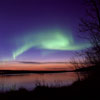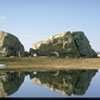Aboriginal People
 Long before Anthony Henday, a Hudson Bay Company fur trader, became the first white man to set foot in the region we now call Alberta in 1754, the land was already populated with many diverse Aboriginal tribes. Given this fact, it is no surprise that there are over 900 places in the province, the names of which can be traced back to Aboriginal origin. When toponymic scholars attempt to compile these names, however, a number of important issues arise.
Long before Anthony Henday, a Hudson Bay Company fur trader, became the first white man to set foot in the region we now call Alberta in 1754, the land was already populated with many diverse Aboriginal tribes. Given this fact, it is no surprise that there are over 900 places in the province, the names of which can be traced back to Aboriginal origin. When toponymic scholars attempt to compile these names, however, a number of important issues arise.
The first issue pertains to the difficulty of transcribing the Aboriginal place names into English. Prior to the arrival of European settlers and traders, Aboriginal culture was orally based, meaning that Aboriginal languages were only spoken, and never written by their people. The problem for the new settlers attempting to survey Alberta's uncharted lands was how to spell words from another language that had never been written out before. Religious missionaries, who arrived in Alberta with the goal of converting the Aboriginal people to Christianity in the mid 19th Century, developed a systematic method of transcribing Aboriginal words into English. Unfortunately, most of the settlers and surveyors doing the actual place-naming did not have access to this system, which resulted in crude and inconsistent transcriptions.
The technical name for the study of representing spoken language in written form is orthography, and even today orthography plays an important role in the study of Aboriginal place names. For example, scholars of Native culture often note that there have been over 30 spelling variations of the word "Saskatchewan," a Cree word meaning "swift current." It is hard to imagine a useful map where the same word is spelled numerous different ways, which is why tracing the origins of certain Aboriginal place names can be such an arduous task.
Another problem one encounters when studying Aboriginal place names is the tendency to find multiple names for the same geographical location. Indeed, Alberta's toponymic history includes reference to at least seventeen different Native tribes, using a total of eight separate languages. Given this, an exact location may have many different names, even if they derive from a common origin. For example, Wetaskiwin is actually a Cree word meaning "place of peace," but its Blackfoot name is inuststi-tomo which translates into the similar "peace hills."
 Sometimes, the opposite phenomenon occurred, and an Aboriginal word referring to a specific location was misapplied by the Europeans to refer to a variety of disparate things. One reason for this phenomenon was that the nomadic lifestyle of early Aboriginal people meant that they would often only name individual sections of a geographical area, depending on which part the tribes encountered on their travels.
Sometimes, the opposite phenomenon occurred, and an Aboriginal word referring to a specific location was misapplied by the Europeans to refer to a variety of disparate things. One reason for this phenomenon was that the nomadic lifestyle of early Aboriginal people meant that they would often only name individual sections of a geographical area, depending on which part the tribes encountered on their travels.  For instance, many Albertans familiar with the name Athabasca probably do not know that it translates literally into "where there are reeds," a phrase that initially referred to only one distinct section of the Athabasca River. Now, because of the European settlers' failure to comprehend the Aboriginal meaning, the name Athabasca has been given to a town, a river, a lake, a mountain, and a number of other geographical locations.
For instance, many Albertans familiar with the name Athabasca probably do not know that it translates literally into "where there are reeds," a phrase that initially referred to only one distinct section of the Athabasca River. Now, because of the European settlers' failure to comprehend the Aboriginal meaning, the name Athabasca has been given to a town, a river, a lake, a mountain, and a number of other geographical locations.
 Unlike the European custom of choosing place names as commemorative tributes to well-known or praised individuals, Aboriginal people refused to name places after anyone either living or dead. Instead, Aboriginal place names often refer to an important event that occurred around the site, or they are outright descriptions of the place itself. Okotoks, example, falls into the latter category, and means "crossing by the big rock," whereas Battle River is a translation from Cree, and commemorates the site of a battle fought between the Cree and Blackfoot tribes in 1802.
Unlike the European custom of choosing place names as commemorative tributes to well-known or praised individuals, Aboriginal people refused to name places after anyone either living or dead. Instead, Aboriginal place names often refer to an important event that occurred around the site, or they are outright descriptions of the place itself. Okotoks, example, falls into the latter category, and means "crossing by the big rock," whereas Battle River is a translation from Cree, and commemorates the site of a battle fought between the Cree and Blackfoot tribes in 1802.
As we can see, even a preliminary examination of Aboriginal toponymies can tell us a great deal about the fraught relationship not only between Native Canadians and their colonizers, but amongst individual tribes as well. These are just some of the hidden cultural histories that emerge through the study of place names.



